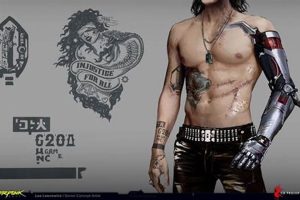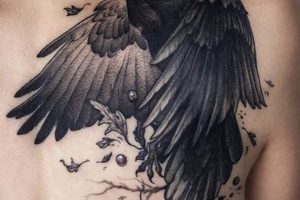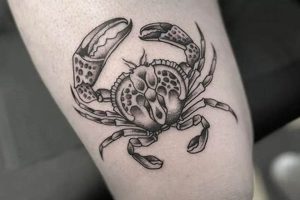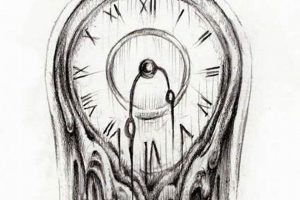Conceptualizing body art featuring dragons involves considering various elements such as the dragon’s style (e.g., Eastern or Western), its pose (e.g., coiled, flying, breathing fire), size and placement on the body, and incorporation of other elements like flowers, tribal designs, or geometric patterns. An example would be a Japanese-style dragon winding around the arm, incorporating cherry blossoms and waves.
Dragon imagery carries significant cultural weight, often symbolizing power, wisdom, protection, and good fortune in various mythologies. Choosing this type of design can be a powerful form of self-expression, reflecting these attributes or personal interpretations. Historically, dragons have appeared in diverse art forms, from ancient pottery to medieval heraldry, demonstrating their enduring appeal as potent symbols.
The following sections will delve into specific design considerations, explore different cultural interpretations of dragons, and provide practical advice on choosing a reputable artist and ensuring proper tattoo aftercare.
1. Style (Eastern/Western)
A fundamental consideration in dragon tattoo design is the stylistic choice between Eastern and Western depictions. This decision significantly influences the tattoo’s visual appearance, symbolic meaning, and overall aesthetic. Understanding the distinct characteristics of each style is crucial for creating a meaningful and impactful design.
- Eastern Dragons
Often depicted as serpentine and wingless, Eastern dragons symbolize wisdom, benevolence, and prosperity. They are frequently associated with natural elements like water and weather. Chinese dragons, for example, are often depicted with long, flowing bodies and elaborate whiskers, while Japanese dragons tend to have three claws and are associated with the sea and good fortune. Choosing an Eastern style imbues the tattoo with these cultural connotations and a sense of flowing, dynamic energy.
- Western Dragons
Typically portrayed with bat-like wings, four legs, and a powerful, reptilian build, Western dragons represent strength, guardianship, but also sometimes chaos and destruction. They are frequently associated with hoarding treasure and breathing fire. Examples include the Welsh dragon, a national symbol of Wales, and the dragons found in European folklore and mythology. Opting for a Western style evokes imagery of ferocity, power, and a connection to ancient legends.
- Hybrid Styles
Blending elements of both Eastern and Western styles allows for unique and personalized designs. This approach offers flexibility in incorporating specific features and symbolic meanings. A dragon might possess the wings of a Western dragon but the serpentine body of an Eastern dragon, creating a visually compelling image with layered symbolism. This fusion allows for creative expression and tailoring the design to individual preferences.
- Impact on Composition
Style significantly impacts the overall composition and placement possibilities. The elongated form of an Eastern dragon lends itself to wrapping around limbs or spanning the back, while the more compact form of a Western dragon might be better suited for the chest, shoulder, or thigh. Understanding these stylistic differences informs decisions about placement and how the tattoo interacts with the body’s contours.
Ultimately, the chosen style shapes the narrative and symbolic weight of the dragon tattoo. Carefully considering these stylistic distinctions allows for a more informed design choice, ensuring the final tattoo resonates with personal meaning and aesthetic preferences.
2. Placement (Body area)
Placement is a critical aspect of dragon tattoo design, influencing the visual impact, symbolic meaning, and overall aesthetic. The chosen body area interacts with the dragon’s form, size, and style, creating a dynamic relationship that enhances the tattoo’s narrative. Careful consideration of placement ensures the design harmonizes with the body’s natural contours and effectively conveys the intended message.
- Back
The back offers a large canvas, ideal for intricate and expansive dragon designs. A sprawling Eastern dragon can coil down the spine, while a Western dragon with outstretched wings can dominate the upper back. The back’s flat surface allows for detailed artwork and creates a dramatic visual statement.
- Chest & Shoulders
The chest and shoulders provide a prominent display area, suitable for medium to large dragon designs. A dragon curled around the shoulder can symbolize protection or strength, while a dragon across the chest can represent courage or power. The curvature of these areas complements the dynamic forms of dragons.
- Arms & Legs
Arms and legs offer opportunities for dynamic, flowing designs that follow the body’s natural lines. A dragon wrapping around an arm or leg can create a sense of movement and power. Smaller, more stylized dragons can be placed on the wrist or ankle for a subtle yet impactful statement.
- Other Placements
Smaller dragon tattoos can be placed on the neck, foot, hand, or behind the ear. These placements offer discreet options for those seeking a less prominent design. Rib cage placements, while less visible, can be particularly meaningful due to their proximity to the heart. Ultimately, placement should align with personal preference and the desired level of visibility.
The interplay between placement and design is crucial for maximizing the impact of a dragon tattoo. A well-chosen placement complements the dragon’s form, enhances its symbolism, and creates a cohesive and aesthetically pleasing composition. Considering the body’s natural contours and the desired level of visibility ensures the tattoo becomes a powerful and personalized form of self-expression.
3. Color & Detail
Color and detail significantly influence the visual impact and symbolic depth of dragon tattoos. Color palettes evoke specific emotions and cultural associations, while the level of detail contributes to the perceived realism and artistic complexity of the design. The interplay between these elements shapes the overall aesthetic and narrative of the tattoo.
Vibrant colors like red and gold in Eastern dragon tattoos often symbolize prosperity, good fortune, and power. Black and grey ink, commonly used in Western dragon designs, can evoke a sense of mystery, strength, and ancient wisdom. Incorporating multiple colors can create a visually striking design, while a monochromatic palette can emphasize the dragon’s form and texture. Detail work, such as individual scales, intricate linework, and background elements, adds depth and dimension to the design. A highly detailed dragon can appear lifelike and powerful, while a more minimalist approach can emphasize symbolic meaning over visual complexity. For example, a Japanese dragon rendered in vibrant blues and greens with meticulously drawn scales and waves evokes the power of the sea, while a tribal dragon depicted in simple black ink with bold lines emphasizes its symbolic meaning of protection and strength.
Careful consideration of color and detail ensures the dragon tattoo effectively communicates the intended message. Balancing these elements creates a visually compelling and symbolically resonant design. The choice of color palette and level of detail should align with the chosen style and placement, resulting in a cohesive and impactful piece of body art. Choosing a skilled artist experienced in various color techniques and detail styles is crucial for realizing the desired aesthetic and ensuring the longevity of the tattoo’s vibrancy and clarity.
4. Size & Composition
Size and composition are integral to the effectiveness of dragon tattoo designs. Scale directly influences the level of detail achievable and the visual impact of the piece. A larger tattoo allows for intricate details like individual scales, complex backgrounds, and dynamic poses, whereas smaller tattoos often necessitate a more streamlined design. Composition, the arrangement of elements within the tattoo, dictates how the eye moves across the design and how the dragon interacts with the body’s contours. A well-composed tattoo utilizes negative space effectively, balancing the dragon’s form with supporting elements to create a harmonious and visually appealing whole. For instance, a large back piece might feature a dragon intertwined with cherry blossoms and waves, the composition guiding the viewer’s gaze across the expanse of the design. A smaller wrist tattoo, however, might focus on the dragon’s head or a stylized claw, maximizing impact within a limited space.
The interplay between size and composition significantly impacts the narrative and symbolic weight of the tattoo. A large, dynamically posed dragon conveys a sense of power and dominance, while a smaller, more intricate design might emphasize themes of wisdom and mystery. Consider a full-sleeve tattoo depicting a dragon in flight amidst swirling clouds and lightning; the scale allows for a dramatic depiction of movement and power. Conversely, a small ankle tattoo featuring a coiled dragon emphasizes a sense of hidden strength and personal significance. Practical considerations also arise: larger tattoos require multiple sessions and greater commitment, while smaller tattoos offer a less time-intensive option. Ultimately, the choices regarding size and composition must align with the individual’s aesthetic preferences, pain tolerance, and the desired symbolic message.
Careful planning of size and composition ensures the dragon tattoo effectively communicates its intended message. Understanding the relationship between these elements and the desired visual impact allows for informed decision-making. Choosing an appropriate scale allows for the desired level of detail, while a well-considered composition enhances the dragon’s form and symbolic meaning. This holistic approach, balancing practical considerations with aesthetic goals, results in a powerful and personally meaningful piece of body art.
Tips for Choosing Dragon Tattoo Designs
Selecting a design requires careful consideration of various factors to ensure a meaningful and aesthetically pleasing result. The following tips offer guidance for navigating the process and making informed decisions.
Tip 1: Research Different Dragon Styles: Explore the rich diversity of dragon depictions across cultures. Eastern dragons, often associated with wisdom and good fortune, differ significantly from Western dragons, frequently symbolizing strength and guardianship. Understanding these stylistic distinctions informs design choices and imbues the tattoo with cultural significance.
Tip 2: Consider Placement Carefully: Body placement impacts the tattoo’s visibility and how the design interacts with the body’s contours. A large, intricate dragon might suit the back, while a smaller, stylized design could be placed on the wrist or ankle. Placement should complement the chosen design and reflect personal preferences.
Tip 3: Choose Colors and Details Wisely: Color palettes evoke specific emotions and cultural associations. Vibrant colors can symbolize prosperity and power, while black and grey ink can create a sense of mystery and strength. Detail work, such as scales and background elements, adds depth and dimension, enhancing the visual impact.
Tip 4: Reflect on Symbolic Meaning: Dragons hold diverse symbolic meanings across cultures, representing strength, wisdom, protection, and good fortune. Consider the desired symbolism and choose a design that resonates with personal values and beliefs.
Tip 5: Consult with a Reputable Artist: Collaborating with a skilled tattoo artist is essential. Discuss design ideas, placement options, and color palettes to ensure the final result aligns with expectations. A reputable artist provides valuable expertise and executes the design with precision and artistry.
Tip 6: Plan for Proper Aftercare: Tattoo aftercare is crucial for preserving the vibrancy and longevity of the design. Follow the artist’s instructions diligently, keeping the tattoo clean and moisturized. Proper aftercare prevents complications and ensures the tattoo heals beautifully.
By considering these tips, individuals can navigate the design process with confidence, resulting in a dragon tattoo that holds personal meaning and stands the test of time. A well-chosen design, executed by a skilled artist, becomes a powerful form of self-expression and a lasting work of art.
The subsequent conclusion will summarize key takeaways and offer final thoughts on the enduring appeal of dragon tattoos.
Frequently Asked Questions about Dragon Tattoos
This section addresses common queries regarding dragon tattoo designs, providing factual information and practical guidance.
Question 1: What is the symbolic significance of dragon tattoos?
Symbolism varies across cultures. Eastern dragons often represent wisdom, prosperity, and good fortune, while Western dragons can symbolize strength, guardianship, or even chaos. Ultimately, the meaning is subjective and can be personalized by the individual.
Question 2: How much do dragon tattoos typically cost?
Cost depends on factors such as size, complexity, artist’s experience, and geographic location. Larger, more intricate designs require more time and thus incur higher costs. Researching local artists and obtaining quotes is recommended.
Question 3: How painful are dragon tattoos?
Pain levels vary based on individual pain tolerance, placement, and tattoo size. Areas with thinner skin or closer to bone tend to be more sensitive. Discussing pain management options with the artist can alleviate discomfort.
Question 4: How long does it take to get a dragon tattoo?
Completion time depends on the design’s complexity, size, and the artist’s working speed. Larger, more detailed tattoos often require multiple sessions, each lasting several hours. Consult with the artist for a time estimate based on the chosen design.
Question 5: What is the best placement for a dragon tattoo?
Optimal placement depends on design size, style, and personal preference. The back offers ample space for large, detailed dragons, while the arms, legs, or chest provide suitable areas for medium-sized designs. Smaller, stylized dragons can be placed on the wrist, ankle, or other less prominent locations.
Question 6: How should a dragon tattoo be cared for after completion?
Proper aftercare is crucial for healing and preserving the tattoo. Follow the artist’s instructions carefully, which typically include keeping the tattoo clean, moisturized, and protected from sun exposure. Proper aftercare prevents infection and ensures the longevity of the design.
Careful consideration of these frequently asked questions ensures informed decisions and contributes to a positive tattooing experience. Understanding the symbolic significance, cost factors, pain levels, time commitment, placement options, and aftercare procedures allows individuals to embark on the process with realistic expectations.
The following section provides a concluding summary and reinforces the importance of careful planning and collaboration with a skilled artist.
Conclusion
Careful consideration of stylistic choices, placement options, color palettes, and symbolic meanings is essential when exploring potential dragon tattoo designs. Understanding the distinctions between Eastern and Western dragon depictions, along with the impact of size and composition, empowers informed decision-making. Collaboration with a skilled and reputable artist remains paramount throughout the process, ensuring the final design aligns with personal aesthetics and desired symbolism.
Dragon tattoos offer a powerful medium for self-expression, allowing individuals to embody the rich cultural heritage and symbolic weight associated with these mythical creatures. Thorough research, thoughtful planning, and meticulous execution transform these designs into enduring works of art, carrying personal narratives and resonating with timeless significance.







